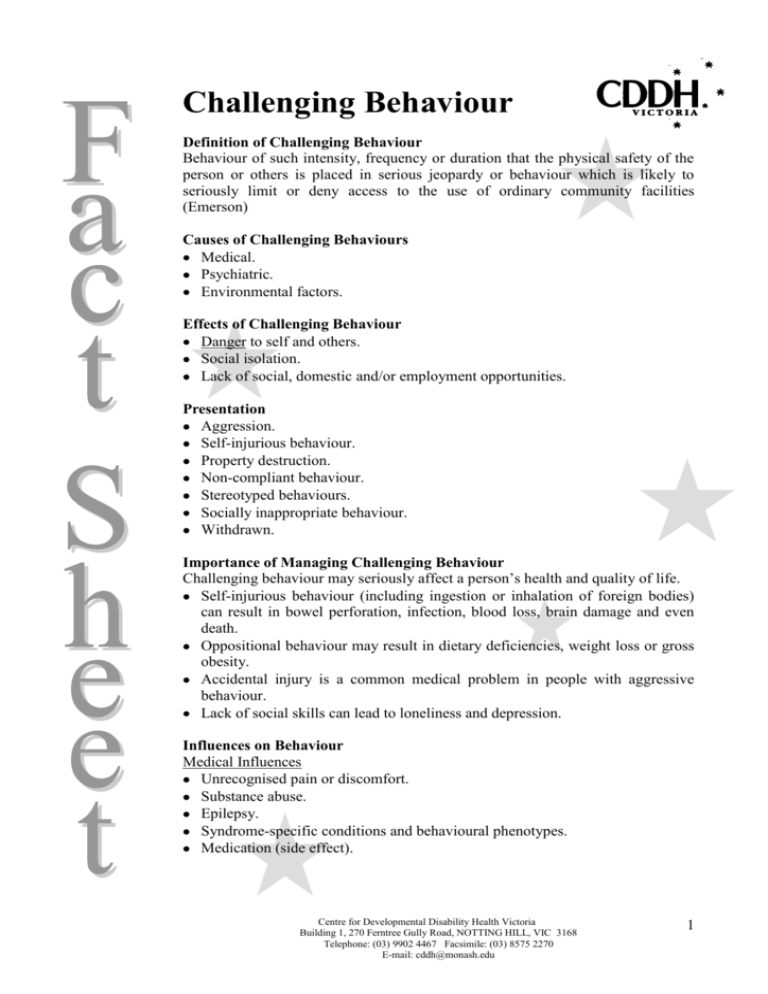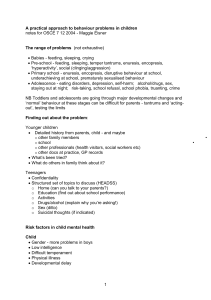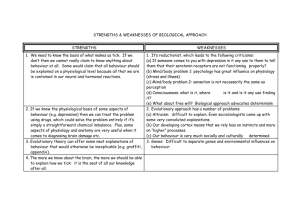Definition of Challenging Behaviour
advertisement

Challenging Behaviour Definition of Challenging Behaviour Behaviour of such intensity, frequency or duration that the physical safety of the person or others is placed in serious jeopardy or behaviour which is likely to seriously limit or deny access to the use of ordinary community facilities (Emerson) Causes of Challenging Behaviours Medical. Psychiatric. Environmental factors. Effects of Challenging Behaviour Danger to self and others. Social isolation. Lack of social, domestic and/or employment opportunities. Presentation Aggression. Self-injurious behaviour. Property destruction. Non-compliant behaviour. Stereotyped behaviours. Socially inappropriate behaviour. Withdrawn. Importance of Managing Challenging Behaviour Challenging behaviour may seriously affect a person’s health and quality of life. Self-injurious behaviour (including ingestion or inhalation of foreign bodies) can result in bowel perforation, infection, blood loss, brain damage and even death. Oppositional behaviour may result in dietary deficiencies, weight loss or gross obesity. Accidental injury is a common medical problem in people with aggressive behaviour. Lack of social skills can lead to loneliness and depression. Influences on Behaviour Medical Influences Unrecognised pain or discomfort. Substance abuse. Epilepsy. Syndrome-specific conditions and behavioural phenotypes. Medication (side effect). Centre for Developmental Disability Health Victoria Building 1, 270 Ferntree Gully Road, NOTTING HILL, VIC 3168 Telephone: (03) 9902 4467 Facsimile: (03) 8575 2270 E-mail: cddh@monash.edu 1 Challenging Behaviour Psychiatric Influences (Is there a family history of psychiatric disorders?) Depression. Mood disorders. Schizophrenia. Environmental (Social and Physical) Influences Gaining social attention. Escape or avoidance of demands. Gaining access to preferred activities or objects. Sensory feedback, eg hand flapping, eye poking. Pursuit of power and control over own life. Reduction of arousal and anxiety. Challenging behaviour. Living and Working Environment Important social and physical environmental factors include: Family background. Cultural factors or values. Economic environment. School and day-occupation setting. Type of accommodation. Rapport with other people in the person’s life. Training and skill of the carers. Opportunity for social interactions. Significant Life Events Moving or moved house. Family disturbance eg marital problems, new addition to the household. Death of a family member or friend. Communication Issues What is the person’s communicative potential? What are the person’s patterns of communication? Are carers able to understand them? What resources are needed to achieve their understanding? Is the person allowed to make choices? Does the person have access to support? Life Stages Age Puberty Menopause Relationships Centre for Developmental Disability Health Victoria Building 1, 270 Ferntree Gully Road, NOTTING HILL, VIC 3168 Telephone: (03) 9902 4467 Facsimile: (03) 8575 2270 E-mail: cddh@monash.edu 2 Challenging Behaviour Assessment, Investigations, Treatment and Referral Assessment of challenging behaviour is dependent on the adequacy of the history. Describing the Behaviour What marks the beginning and the end of an episode? What usually happens before, during and after an episode? How frequent and severe is the behaviour at its worst? Where and when does the behaviour occur? Historical Background to the Behaviour When did the behaviour first begin? What else was happening at the time? Who was present at the time? What has happened since then? Is the behaviour getting worse, better, staying the same? Has the Behaviour been constant or remitted and recurred over time? Is this a new behaviour or a long-standing behaviour which has now become unmanageable? What treatment has been tried? What worked? What failed? What treatment is presently in place? Legal Implications of Treatment Each state has legislation that covers the use of restrictive, aversive or intrusive interventions in people with a developmental disability. It is important to be familiar with these requirements before proceeding with pharmacological or behavioural interventions. The material in this sheet has been adapted from the Therapeutic Guidelines book ‘Management Guidelines for People with Developmental and Intellectual Disabilities’ and updated from the 2005 version, Management Guidelines – Developmental Disability’ which can be consulted for more detailed information. Sheet revised: June 2005 Centre for Developmental Disability Health Victoria Building 1, 270 Ferntree Gully Road, NOTTING HILL, VIC 3168 Telephone: (03) 9902 4467 Facsimile: (03) 8575 2270 E-mail: cddh@monash.edu 3







